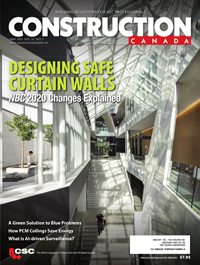Specifying concrete repair
Unfortunately, it appears that ASTM C494, Standard Specification for Chemical Admixtures in Concrete—which allows 35 per cent more shrinkage in test specimens with the admixture than that of control specimens—is too often disregarded. This means using low w/c and WRAs to keep the necessary workability may not always result in the expected shrinkage decrease. Instead, it can actually end up causing an increase in shrinkage and result in cracking.
Specifications that unintentionally increase the shrinkage can lead the concrete to experience severe cracking. Figure 2 illustrates some of the material properties critical for a low-cracking, durable material.
Permeability
One of the fundamental factors influencing the initiation and the extent of damage to reinforced concrete is its permeation characteristics. The movement of moisture—which can contain aggressive agents—is fundamental to the repaired structure’s durability. This transport mechanism can produce detrimental physical, chemical, and electro-chemical effects.
Specification of chloride permeability limits based on ASTM C1202, Test Method for Electrical Indication of Concrete’s Ability to Resist Chloride Ion Penetration, is a regular practice in North America, and almost all specifications limit the repair material’s permeability based on this standard. During this test, crack-free specimens are formed in the laboratory or extracted in the field. According to ASTM C1202, the permeability of 400 coulombs is ‘very good,’ while 4000 is ‘very bad’ (Figure 3).
Of course, the material’s micropermeability has to be considered and limited—but only after macropermeability issues are successfully addressed by specifying an allowable drying shrinkage value. Specifications for cement-based materials with requirements for durability must set up criteria for drying shrinkage. The time to corrosion is first controlled by the transport of aggressive agents on the macrostructural level, and then on the microstructural level. Aggressive agents in the vicinity are ignoring diffusion and instead taking the path of least resistance—the network of cracks and microcracks.
The primary significance of deformations caused by moisture-related effects in cementitious materials is whether their interaction will lead to cracking. Here, the magnitude of the restrained shrinkage strain is the most important to be specified. Linking the two aspects of permeability (i.e. macro and micro) is a measure of the cement-based material as it is—its so-called protective character. There can be little doubt macropermeability is perhaps the most important of all.
Factors to be analyzed by the repair project’s engineer/specifier are presented in Figure 4. The most critical engineering issues to be addressed to achieve durability are collectively called ‘compatibility factors.’ The meaning of compatibility in concrete repair composite systems relates to a balance of the physical, chemical, and electrochemical properties and deformations between system components (e.g. existing substrate, repair, and transition zone between them). This balance ensures the whole system can withstand stresses induced by restrained volume changes, chemical, and electrochemical effects without premature deterioration
or distress over a designed period. Figure 5 summarizes the most important factors to be considered
in compatibility analysis.
Corrosion-inhibitors
Many specifications call for use of corrosion-inhibitors in concrete repairs. While these admixtures appear to offer added protection against corrosion in newly constructed concrete structures, there are some concerns and uncertainties related to their use in repairs. In other words, they can become an aspect of the problem, rather than a solution.
When a corrosion-inhibitor is added to the repair material, the local nature of the repair does not address the whole structure’s predicament if chlorides or carbonation are widespread. Even when the local repair contains the necessary concentration of the inhibitor, it can become a clean (i.e. non-corroding) cathodic area that stimulates increased corrosion around it, causing a ‘ring effect.’ In numerous cases, repair procedures of this type have resulted in early cracking and spalling in the original concrete adjacent to the repair.
Another concern is how to maintain the inhibitor’s necessary concentration in the repair area. It is likely the inhibitor will spread beyond this point and migrate with water and other ions, causing the effective concentration to be reduced. The inhibitor solution can in fact move in response to concentration, moisture, and temperature gradients occurring between different parts of the structure.
Both moisture and temperature gradients determine the transport of water and other agents, via water, in the repair system. This flow can be significant when the structure is subjected to wetting and drying. It is also more than likely chloride ions from chloride-contaminated existing concrete will move into the repair phase by the aforementioned transport mechanism (Figure 6).
The specified slider id does not exist.







